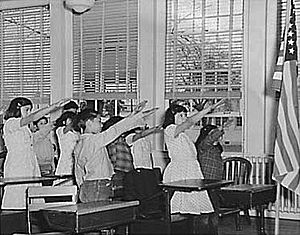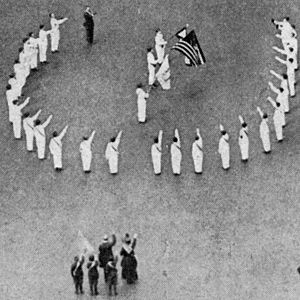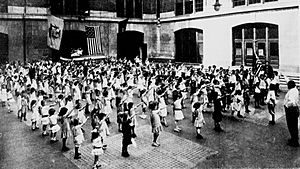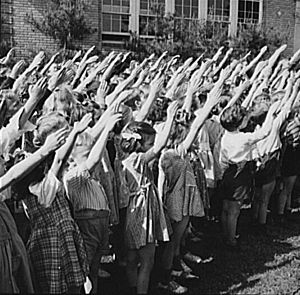Bellamy salute facts for kids

The Bellamy salute was a special way of saluting the flag of the United States. It was created by James B. Upham to go with the American Pledge of Allegiance. This salute was also called the "flag salute." It became well-known because Francis Bellamy, who wrote the Pledge, promoted it. Both the Pledge and this salute started in 1892.
Later, in the 1920s and 1930s, groups in Italy (called fascists) and Germany (called Nazis) started using a very similar salute. People mistakenly thought this gesture was an old Roman salute. Because of this similarity, the Bellamy salute became controversial in the United States. It was officially replaced with the hand-over-heart salute on December 22, 1942. This change happened when the U.S. Congress updated the Flag Code.
History of the Bellamy Salute

How the Salute Began
The Bellamy salute was invented by James B. Upham. He was a partner and editor at a magazine called The Youth's Companion. Francis Bellamy, who wrote the Pledge of Allegiance, remembered how Upham came up with the salute. Upham stood up, clicked his heels, and said, "Now up there is the flag; I come to salute." He then showed how to stretch out his right hand while saying the Pledge.
The Bellamy salute was first shown to the public on October 12, 1892. This was during the "National School Celebration of Columbus Day." Instructions told students to stand in rows, facing the flag. They would lift their right hand, palm down, to their forehead. Then, as they said the Pledge, they would extend their right hand, palm up, toward the flag. They would hold this position until the end of the Pledge.
Why the Salute Changed
In the 1920s, Italian fascists started using a salute that looked like an old Roman salute. This was to show they were bringing back Italy's greatness, like in ancient Rome. The German Nazis also adopted a similar gesture, known as the Nazi salute.
Because these salutes looked so much like the Bellamy salute, people in the United States became worried. There was a lot of discussion about whether Americans should keep using the Bellamy salute. Some school boards changed how the salute was done to make it less similar. However, groups like the United States Flag Association and the Daughters of the American Revolution felt it was wrong to change an American tradition because of other countries.
During the time leading up to World War II, some people tried to make Americans who didn't want to join the war look bad. They used pictures of people like Charles Lindbergh doing the Bellamy salute. These pictures were often taken from an angle that hid the American flag. This made it look like they were doing the Nazi salute instead.

On June 22, 1942, Congress passed a law about how to show respect for the flag. This law, called Public Law 77-623, included rules for the Pledge of Allegiance. It said people should stand with their right hand over their heart. Then, they would extend their right hand, palm up, toward the flag. They would hold this position until the end of the Pledge.
Congress later changed this rule on December 22, 1942. In Public Law 77-829, they stated that the Pledge should be said "by standing with the right hand over the heart." This officially replaced the Bellamy salute with the hand-over-heart gesture we use today.
See also
 In Spanish: Saludo Bellamy para niños
In Spanish: Saludo Bellamy para niños



